Most homeowners never think about masonry chimney maintenance beyond the occasional flue cleaning. Read more
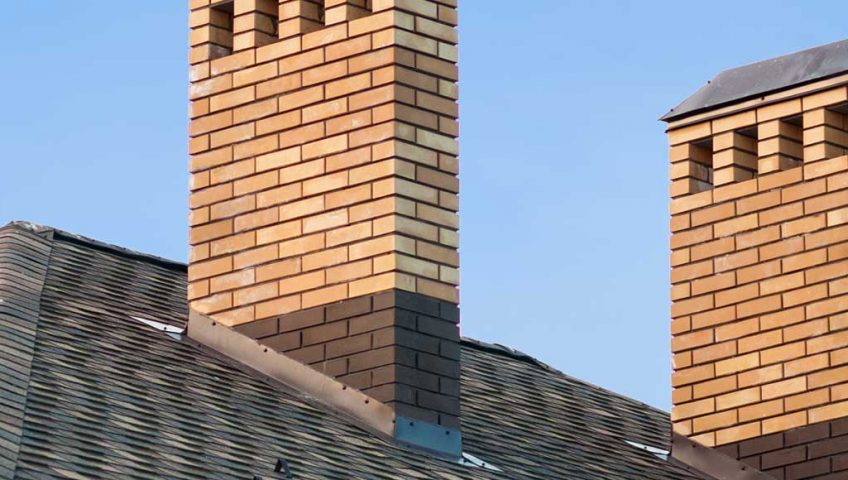

Most homeowners never think about masonry chimney maintenance beyond the occasional flue cleaning. Read more

Wishing you a 2014 filled with health, happiness and prosperity. Read more
What is an Ice Dam?
Ice dams are formed by continual thawing and refreezing of melting snow. Large masses of ice develop as snow on the upper part of the roof melts. The water runs under the snow and refreezes at the edge of the roof. Additional snow melts and forms pools against the dam gradually causing water to back up the roof often getting under the shingles and eventually leaking into the house.
What causes Ice Dams?
How to prevent Ice Dams?
The goal is to keep the entire roof the same temperature as the eaves. You do that by increasing ventilation, adding insulation, and sealing off every possible air leak that might warm the underside of the roof.
Northern Building Services can help out (just call 905-717-0334). We can:
As you may know, eaves-troughs are installed to control the flow of water and divert water to a safe location. But keep in mind that eaves-troughs become very easily clogged and require preventative maintenance 2 times per year:
Eaves-troughs are part of a home that many owners pay little attention to…until it’s too late! Avoid costly water damage due to eaves-trough maintenance neglect.
Did you know that the Ministry of Health and Long Term Care encourages regular cleaning of your eavestrough as a means of protection against West Nile Virus?
60% or more of mosquitoes in your neighbourhood come from clogged eaves-troughs, or badly sloped eaves-troughs.
Northern Building Services provides eaves-trough cleaning services in your neighbourhood. Simply call 905-717-0334.
The following images will help you identify the potential for roof failure. Or call us and we will help you with the inspection.
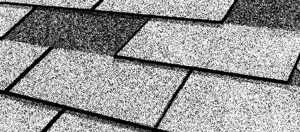 The protective granular surface of shingles wears off as the asphalt, into which the granules are embedded, begins to harden over time. Bare spots are often accompanied by fine fissures on the shingles’ surface and by the accumulation of granules in the gutters.
The protective granular surface of shingles wears off as the asphalt, into which the granules are embedded, begins to harden over time. Bare spots are often accompanied by fine fissures on the shingles’ surface and by the accumulation of granules in the gutters.
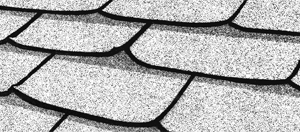 The upward curling of shingle tabs makes them highly susceptible to wind and ice damage. This is a problem on older roofs where moisture build-up in the attic affects the underside of the shingle.
The upward curling of shingle tabs makes them highly susceptible to wind and ice damage. This is a problem on older roofs where moisture build-up in the attic affects the underside of the shingle.
 Damage can be caused by extreme wind conditions and snow removal. Since shingles are supposed to shed water, broken, torn or missing tabs become obvious entry points for water, especially on low slope roofs where run-off is slower and at the peaks of the roof where shingles are the most vulnerable to high winds.
Damage can be caused by extreme wind conditions and snow removal. Since shingles are supposed to shed water, broken, torn or missing tabs become obvious entry points for water, especially on low slope roofs where run-off is slower and at the peaks of the roof where shingles are the most vulnerable to high winds.
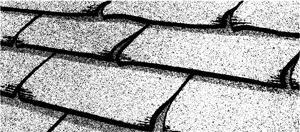 This is the curling under of the shingle tab’s bottom edge and is part of the normal aging process of shingles. The bulge created is susceptible to substantial damage by wind action, hail and ice.
This is the curling under of the shingle tab’s bottom edge and is part of the normal aging process of shingles. The bulge created is susceptible to substantial damage by wind action, hail and ice.
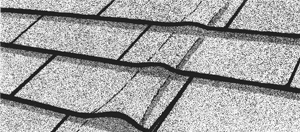 Buckling is a visible distortion or waviness in the horizontal lines of shingles, and usually runs in a straight line up the roof slope. Shingle tabs become exposed to wind and can be torn off. Very often, the problem is warping in the roof deck caused by poor attic ventilation. The use of thinner-than recommended plywood and other non-plywood materials adds to the problem.
Buckling is a visible distortion or waviness in the horizontal lines of shingles, and usually runs in a straight line up the roof slope. Shingle tabs become exposed to wind and can be torn off. Very often, the problem is warping in the roof deck caused by poor attic ventilation. The use of thinner-than recommended plywood and other non-plywood materials adds to the problem.
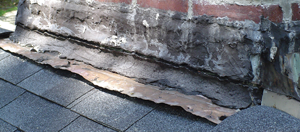 Many problems occur at the flashings around vents, soil stacks, chimneys and vertical wall joints. Is the flashing cracked? Is the caulking around the flashing dried out? Are the shingles that lie over the flashing in good shape?
Many problems occur at the flashings around vents, soil stacks, chimneys and vertical wall joints. Is the flashing cracked? Is the caulking around the flashing dried out? Are the shingles that lie over the flashing in good shape?
Thanks to Building Products of Canada for supplying the images and text.
Don’t wait until a small masonry problem turns into a big masonry problem. Masonry damage should be repaired promptly because it can lead to other problems:
Work done by a masonry specialist can last for decades and often increase a home’s value by restoring the integrity of exterior surfaces and enhancing the curb appeal.
A properly executed window sill replacement can extend the life of your older windows by preventing further rot in and around the windows. Be sure to properly seal and paint your windows on a regular basis and you will not have to worry about another window sill replacement for a long time.
Whether you have your heart set on a new design or your sills are falling apart, we are your window sill replacement experts.
It would depend on how often the system is used, but we do recommend that your chimney is inspected annually. We could then advise you of the chimneys condition, including the masonry, brickwork, firebox, and flue. Quite often a minor repair or use suggestion can save you a costly expense in the future.
The short answer is: YES.
A Chimney Repairman should inspect the complete wood burning system including the chimney at roof level. They will be able to properly advise you of any problems and if a chimney cleaning is required. They would also be able to advice on the proper use of the damper and correct wood burning procedures.
Attic ventilation is an important part of every roof installation. The proper method of ensuring air flow in your attic is a ridge venting system. These are structures with molded-in air vents located under the ridge cap shingles. The system provides the desired airflow in the attic while maintaining watertight integrity.
How to do it right: If there isn’t enough airflow in the attic, mold may grow and plywood may delaminate and rot. Box vents can provide attic ventilation, but are prone to leakage and are unsightly. A ridge vent system provides better airflow than box vents and will not leak. It also gives your home a higher profile and a more attractive look.